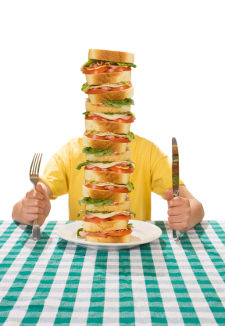How to Train Yourself to Eat Less

To lose weight and keep it off, it’s crucial to train yourself to eat less. But how do you do that without feeling deprived?
As a Nutrition Coach, I've come up with a list of the best strategies to help you do just that.
You'll also find several worksheets to help you work through some of the strategies. (These are the same worksheets I use as a Nutrition Coach.)
At the end, I give you suggestions on What To Do Next. It's easy to read about these strategies; applying them and changing your habits is what's going to transform you!
Here are my top eight strategies to train yourself to eat less:
1) Train yourself to take smaller portions.
This is where most of us go wrong from the start, by using a large dinner plate and filling every bit of available space with food. That’s a sure recipe for overeating if there ever was one.What can help you eat less is to understand what portions are right for you.
I have two strategies you can use:
Strategy #1: Hand-Sized Portion Guide
This method uses something you’ve got with you all the time: your hand!
Your hand is also unique to you. So, the portions should be just right for you.
- You use your palm to judge your protein serving .
- Your fist is a serving of vegetables.
- Carb dense foods is a cupped hand.
- And your thumb represents a serving of fat.
Women can start off with one portion of each for a meal; males, two servings of each. Do this three times a day or four, if you’re active.
Download the Hand-Sized Portion Guide
Strategy #2: PN Plate Guide
As a PN Nutrition Coach, the PN Plate Guide is something I recommend often. It’s a helpful visual guide on how to divide up your plate.
Women, use a smaller plate. Men, a regular plate
Download the PN Plate Guide
See: Eating Smaller Portions: Painless Tips and Strategies
2) Train yourself to eat slowly.
Gulping down your food too quickly is another sure way to eat more than your body really needs.When you slow down and enjoy every bite, you feel satisfied with less food.
Be sure to chew each bite completely and pause for a few seconds before you take another bite.
Doing this through your entire meal will absolutely encourage you to eat far less than you normally would.
Learn more strategies to eat slowly here: How to Eat More Slowly
Want to track whether you're eating slowly? I have a simple worksheet to journal your meals and track whether you ate slowly or not.
Download The Eating Slowly Meal Journal Worksheet
See: You Need to Slow Down to Lose Weight
3) Train yourself to unscramble your hunger cues.
Another reason we overeat is we’ve lost touch with our hunger cues. We get sad, stressed or even happy, and we think we’re hungry.After years of being told what to eat and when to eat, we’ve learned to ignore our hunger cues. Especially when cravings hit!
So, let’s play a little game called The Hunger Game.
The goal of this game is help you become aware of your hunger cues, and help you figure whether you “want” to eat or “need” to eat.
It’s a series of worksheets to help you understand your hunger -- and fullness - cues.
The first page of the guide shows a sample timelines you how you should be feeling:
- Just before eating
- Immediately after eatin
- One hour after finishing
- Two hours after finishing
- Three to four hours after finishing
- Four or more hours after finishing
You can then track on a scale of 1 to 10 how hungry you are when you start eating -- and how full you are when you finish eating. You can also write down what you were feeling at the time.
Download The Hunger Game worksheets
4) Train yourself to eat till 80% full.
This is one of the core “anchor” habits of my nutrition coaching program. (Eat slowly is the other anchor habit.)It might take some time to figure this one out. Eating slowly can help you do this.
You know how you feel when you’re overstuffed, right? Bloated, can’t move, lethargic -- maybe even some guilt?
Eating to 80% full is the opposite of that. You feel a bit light. You feel like you could take a walk.
Another plus about eating till 80% full? Not only do you feel great but you have leftovers to eat another day. So, less cooking. (Hey, I’ll try to find all the positives if it helps you!)
5) Track your food intake from Friday to Sunday.
This one happens more often than you think. You eat normal size portions of healthy foods throughout the week.But then, by Friday, you’ve checked out. It’s the weekend. You’ve been “good” all week. So now’s the time to reward yourself.
For most people, this is where you can make the biggest changes to how and what you eat.
Track what you eat -- and drink! -- from Friday to Sunday night. You don’t have to count calories or measure things out exactly. You can use the hand-sized portion guide as a measure.
Analyze where you cut back a bit. Can you see areas where you can make changes?
If you order out every Friday night, how about planning a meal the weekend before that you can eat Friday night instead?
Download the 3-Day Diet Record Worksheet
6) Change your emotional relationship with food.
Oh, food. You make us feel so good. And then you make us feel so bad.If you tend to have several episodes of unwanted eating habits, there’s a worksheet that can help you “break the chain” of overeating.
Oftentimes, something will trigger that unwanted episode. It might be a certain situation (getting home late from work, all stressed out). It might be a certain feeling (“I’m such a failure.” “Why did I say that stupid thing at work? I’m SUCH an idiot.” )
Write down what you were feeling before, during and after the episode. it can help you track down situations and feelings that trigger an episode.
Once you know what triggers the episode, you build strategies to avoid overeating when these triggers appear.
Download the Break the Chain Worksheet
7) Train yourself to pause for a few seconds and ask yourself these three questions.
You can have the best intentions to eat better in order to lose weight. But if you’re eating mindlessly, your calorie intake will be over and above what you need to lose weight.What can help is to pause just before eating and ask yourself these three questions:
- Am I Hungry?
- Is it Healthy?
- Will It Help Me (reach my goals)?
What you eat is totally up to you. If you answer NO to each of those questions and still want to eat, then go ahead. You’re at least making a conscious choice to eat, instead of eating mindlessly.
More details about this strategy here: 3 Questions To Ask Yourself Before Eating that Food You REALLY Want to Eat
8) Take a break from your #1 food nemesis for 5, 10, 15 or even 30 days.
When I was a kid, my family used to call me the "spaghetti monster." Whenever we had spaghetti, I'd clean my plate, ask for seconds and then clean everybody else's leftovers!Even as an adult, I'd eat spaghetti several times a week. Okay, maybe even every day. And yup, I'd usually overeat each time.
It took challenging myself not to eat spaghetti for a month to break the habit. And now that it's broken, I'll have pasta once a month. I don't feel deprived; I don't feel like I'm missing out on anything.
Spaghetti was just a habit that could be broken, like any other habit.
Are there some foods that make you forget about portions and serving sizes? Can you challenge yourself to live without them for 30 days. Not forever. Just a short 30 days.
If you can’t do 30 days, how many days are you ready, willing and able to try? (<---- That's another worksheet, by the way!)
Whatever number of days you choose, check out my 5 Steps to a 30 Day Lifestyle Challenge. The five steps will work even for fewer than 30 days.
What To Do Next
These eight strategies to train yourself are the most effective to help you lose weight and feel better.But it would be overwhelming to try to do them all at the same time. Here's what I suggest you do instead:
Ask yourself, are there any strategies I mentioned that resonated with you? Any that you thought, “Yes, I can do THAT one!”
Pick one strategy that excited you and try it out for two weeks. Once you get a handle on that one, see if you can add one more to practice for two weeks.
These strategies -- and practicing habits for two weeks -- are all part of my online nutrition coaching program.
Not sure which one excites you the most? Start with eating slowly and then move on to eating till 80% full.
Do those two habits 80% of the time and you'll see major changes in your eating habits.
Must Read
49 Ways to Eat Fewer Calories
10 Easy Ways to Eat Less and Lose Weight
Eating When Upset: Can It Stall Weight Loss?
Break The Habit of Eating While Doing Other Activities
